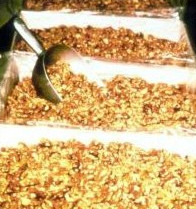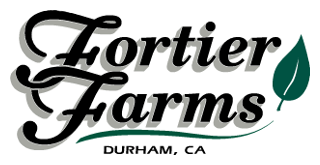 There are 37 varieties of walnuts grown in California. However, four varieties account for over 80% of total California walnut production: Ch andler, Hartley, Payne and Serr.
There are 37 varieties of walnuts grown in California. However, four varieties account for over 80% of total California walnut production: Ch andler, Hartley, Payne and Serr.
Chandler
Harvest mid-season; large smooth oval nut, with good shell seal, and high quality kernel. Kernel color is excellent, light grade consistently 90% or better. Has potentially high fruitfulness with 80-90 percent of lateral buds fruitful. Medium size tree is a moderately vigorous and semi-upright, highly productive tree. Pollenizers are Cisco and Scharsch Franquette.
Chico
Small, upright, early harvest, highly productive tree. Nut size is small with excellent kernel quality. Due to smaller size trees and a very high percentage of lateral pistil late; bloom 90-100%. It is well suited for high-density plantings. Pollenizers are Payne, Serr or Sunl and.
Cisco
Its main attribute is as a pollenizer for Ch andler and Howard. In growth habits Cisco is semi-upright and a small tree.
Daniels
The tree bears heavily, and the nut is thin shelled, medium sized, and cracks out at about 40% kernel.
Eureka
Tree is very large, somewhat spreading growth habit. Harvest early to mid-season. Nut is medium size elongated with a good shell seal.
Franquette
A late leafing Californian variety which is good for areas with late spring frosts. Unfortunately, its late flowering also means it misses the pollen shed by other varieties, so nut set and yields are often poor. It may be worth trying ‘Mayrick’, also late flowering, as a pollenizer, or ‘Rex’. Most Californian varieties are susceptible to walnut blight, and are therefore poorly suited to wet and humid areas, but Franquette seems to have some degree of blight resistance. Franquette is a terminal bearer. The nuts are large, and attractive. Crack out is around 31%. Franquette reputedly also has very high quality timber.
Hartley
of light kernels nearly 90%. Tree size is moderate to large, moderately spreading with good vigor on fertile soil. Hartley needs 40 to 45 foot spacing for mature tree. Most widely planted walnut variety in California. Acceptable pollenizers are the late blooming Amigo and Scharsch Franquette.
Howard
Harvest mid-season; nut is large, round and smooth with a good seal. Kernel quality is excellent at 90% light, and kernel percentage is 50%. Tree size is small to medium and semi-upright with moderate vigor, which makes it a good c andidate for high-density plantings. Pollenizers are Cisco or Scharsch Franquette.
Payne
Harvested early in the season. Payne nut size is medium to small. Shell seal is very good. Nuts average 48% kernel with approximately 50% light. Yield potential is high to very high. Approximately 80% to 90% of the lateral buds on shoots are fruitful. Very productive. Tree is medium round shaped. Heavy pruning is required when trees are young to avoid overbearing.
Pedro
A particularly desirable walnut for the home gardener because it is a relatively ‘small’ tree at about 9 meters/30 feet high. It is self fertile, needing 400 hours of winter chill (not suited to areas with late frost), and the nut is both well sealed and particularly liked when tested in consumer taste panels.
Sauber 1
Anthracnose resistant, heavy and reliable producer, large nut, 35% crack out.
Scarsch Franquette
Late harvest. Nut size is small and well-sealed, very good quality light kernel. Trees are large and require 40 to 50 foot spacing. Vigor is moderate to high and tree shape is upright. Good pollenizer for Hartley and Ch andler.
Serr
Harvest is early to mid-season. Nut size is large, with a fair to good shell seal. Kernel is 60% light. Percentage of kernel is high at 59%. Serr planted on shallower, heavier, or less fertile soil seems to bear better. Serr tree size is large and requires a spacing of at least 40 feet. Shape is moderately spreading and vigor is good to excessive. Suitable pollenizers include Chico and Tehama.
Sparrow
A partially self-fertile tree producing heavy crops of medium sized, nice flavored, well-filled nuts.
Tulare
Harvest mid-season. The nut and kernel are large, with a well-sealed, nearly round nut. The Tulare requires no pollenizer. Tree has upright growth habit, moderately vigor, suitable for hedge row and other high-density planting systems.
Vina
Harvest early to mid-season; medium size pointed nut, with a good shell seal. Kernel color is good at 60% light with 48% kernel. Tree size is small to medium; vigor is moderate to good and highly productive. Pollenizers are Chico, Ch andler, Howard and Tehama.
This information was acquired through the Walnut Marketing Board
